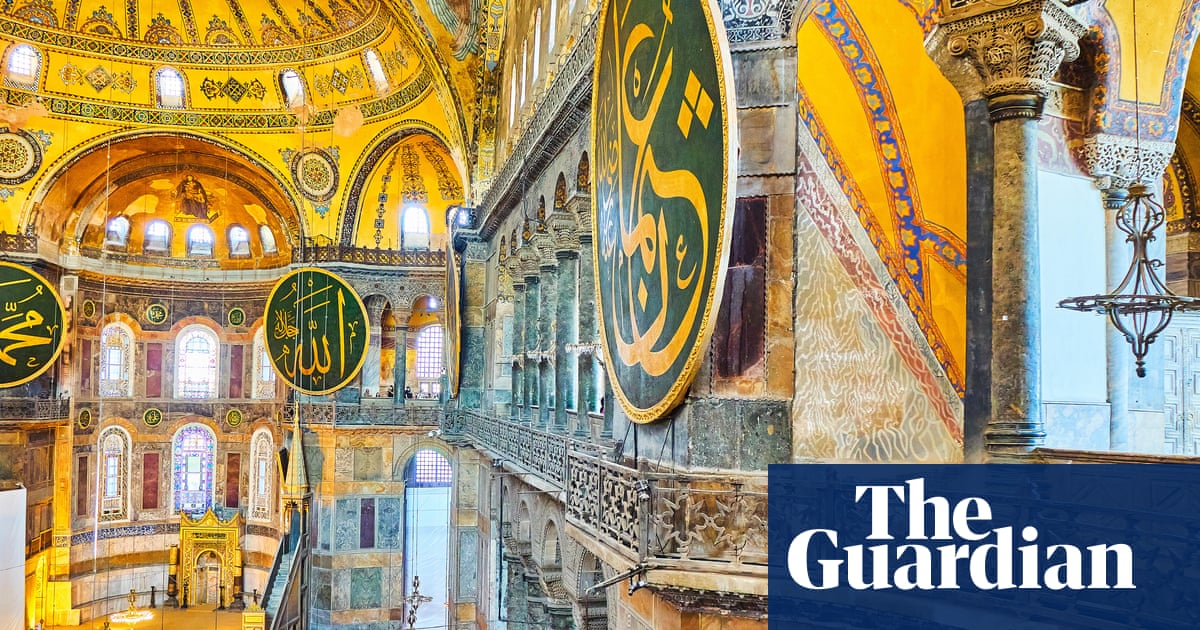Standing beneath the stone archways, grand murals and filagree lamps of the Hagia Sophia, the architect Hasan Fırat Diker reflects on his vocation: the protection of a fragile structure that is both Turkey’s grandest mosque and perhaps its most contentious building. He is overseeing some of the most intense restoration and preservation works in the Hagia Sophia’s nearly 1,500-year history, including efforts to strengthen its grand central dome and protect it from earthquakes.
“We are not just responsible for this building but to the entire world public,” Diker said, gesturing at the crowds of visitors kneeled on the plush turquoise carpets or gazing at the murals of feathered seraphim. He pointed up at the gold mosaic and blue mural interior of the main dome, what he describes as one of the many “unsolved problems” of the Hagia Sophia’s design.
The imposing structure, first built in AD537 under the Byzantine (or eastern Roman) empire, is visibly uneven in places, in particular the grand dome, which for hundreds of years has sat perched atop four columns of different dimensions. The entire building is a patchwork of repairs after the collapse of the original dome in an earthquake in 558 plus several of the surrounding half-domes in later tremors.
The Hagia Sophia still bears features from when it was one of the world’s grandest cathedrals before its conversion into a mosque after the Ottoman conquest in 1453 of what was then Constantinople.
Transformed into a museum under the Turkish republic in 1935, a Turkish court controversiallyreclassified it as a mosquefive years ago. The decision sparked fierce criticism, including from Unesco, which called the Hagia Sophia “an architectural masterpiece” and said the decision to reclassify it undermined “the universal nature of its heritage”.
Diker’s role, alongside other architects, engineers and art historians appointed by the Turkish authorities, will be to conduct the most extensive restoration works in years. The team will remove the lead covering the main dome and look for ways to strengthen the fragile joints between the semi-domes and the main cupola in order to prevent earthquake damage.
They will also examine the four supporting pillars and parts of the structure below ground. “This may be one of the greatest restorations of the current period in Turkey,” Diker said.
Their mission only proved more pressing when last month a 6.2-magnitude earthquake struck off the coast of Istanbul, causing buildings across the city to tremble. Diker immediately rushed from his office to peer at the mosque’s interior and inspect for damage.
Turkey sits atop two fault lines, making it extremely susceptible to earthquakes, which can prove deadly when combined with infrastructure issues. Two powerful earthquakes that struck the country’s south-east in early 2023 killed more than 53,000 people, and destruction covering the size of Germany was blamed on widespread corruption in the construction industry.
Istanbul, a city of 16 million people, densely packed older buildings and architectural wonders, reckons daily with fears of the next large quake. “In the most terrifying scenario, an earthquake will shake the entire structure,” Diker said. “The main arch connecting the main dome and semi-domes could tremble and there might be cracks that occur.” An earthquake could also jolt the minaret into the domes, or cause the arches to collapse entirely.
Diker gestured to trace the arc between the two squat domes either side of the grand central dome as he pointed to patchworks of three separate periods of restoration and repair since the sixth century.
“For the moment, we will deal with the outer surfaces, the minarets and the main dome. We will better understand after removing the dome’s lead covering,” he said.
“These reconstructions over different periods created layers of buildup on the dome’s surface … we know at the moment it’s not a perfect sphere due to the multiple interventions. The problem is not the dome itself but what is holding it up – for now. But when we uncover it we will better see the cracks.”
The team will peel back hundreds of years of the building’s history to look at how to strengthen the structure. They are also hoping to uncover hidden murals from Hagia Sophia’s time as an Ottoman mosque that may lie beneath some of its gold and yellow surfaces.
The restoration works have no set timetable, and the scaffolding soon to cover the interior is intended to allow for business as usual, while a specially designed cover will protect the fragile exposed surface of the dome from rain or intense heat.
“We need to care for the comfort of our visitors,” Diker said. “Those who come here should be able to see as much of the Hagia Sophia as they can despite the restoration.”
